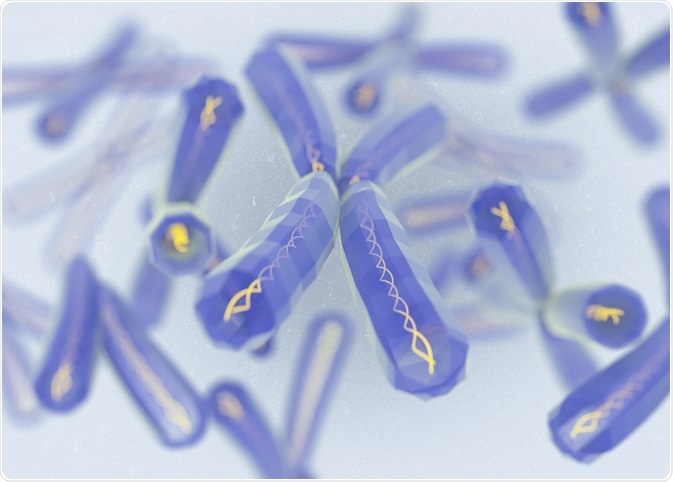Chromosomes are vital components of eukaryotic or prokaryotic cells, in which an entire genome is stored. Aside from the gametes, human cells (autosomes) each contain 23 pairs of chromosomes, giving a total of 46 chromosomes per cell. Male and female gametes have only one copy of each of the 23 chromosomes rather than pairs, and only form a cell that has the complete set of chromosomes after they unite in fertilization.

Image Credit: Anatomy Image / Shutterstock.com
In a process called karyotyping, the pairs of autosomal chromosomes can be ordered, classified and numbered according to their size and the twenty-third pair are the sex chromosomes (XX for females and XY for males).
What is chromosome 1?
Chromosome 1 is the largest human chromosome, made up of around 249 million nucleotide base pairs and representing approximately 8% of the entire DNA content within a human cell. Research into chromosome 1 has shown that it contains around 4,220 genes and was the last gene to have its DNA sequencing completed by The Human Genome Project, over thirty years ago. The proteins these genes code for perform a variety of essential roles in the body.
As the largest chromosome, chromosome 1 is the most susceptible to polymorphisms or mutations. Polymorphisms are variations of the chromosomal base pairs that are present in at least 1% of the general population. Polymorphisms can involve one or more base pairs. When they involve single nucleotides, they are termed single nucleotide polymorphisms (SNPs). On Chromosome 1, there are an estimated 740,000 SNPs and it is thought that at least 22 loci are polymorphic among the European population.
A wide range of disorders and abnormalities can therefore be attributed to variations at the loci of chromosome 1. More than 350 diseases have been linked to abnormalities in the sequence of chromosome 1 including cancers, Mendelian disorders, as well as various developmental and neurological diseases, where the causative gene mutations have not yet been identified.
Chromosome 1 mutations
Changes to the structure or number of chromosomes can also cause a variety of diseases and developmental disorders. Below are some examples of the conditions that occur when these changes affect chromosome 1.
1p36 deletion syndrome
The 1p36 deletion syndrome is caused by the deletion of genetic material on a particular region of the short (p) arm of chromosome 1. Symptoms of this condition include impaired intellectual ability and characteristic facial features, both of which are likely to be linked to the deletion of multiple genes across this chromosomal region.
Neuroblastoma
Neuroblastomas have also been associated with deletions that occur in the 1p36 region of chromosome 1. In this illness, a cancerous tumor develops that is made up of immature neurons, called neuroblasts.
Around a quarter of affected individuals have a deletion that spans 1p36.1 – 1p36.3, which causes a more severe form of the condition. Researchers believe the deletion affects an area containing a gene that prevents abnormal cell division and proliferation. These genes are referred to as tumor suppressor genes. The deletion of tumor suppressor genes in this way can lead to abnormal cell growth and cancer.
1q21.1 microdeletion
A microdeletion of 1q21.1 involves the deletion of a small portion of the long (q) arm of chromosome 1, with around 1.35 million DNA base pairs or 1.35 megabases (Mb) that are missing in the q21.1 region of the chromosome. Exactly how large the deletion is can vary, but usually, at least nine genes are contained in the region.
Signs of the disease such as developmental delay, impaired intellectual ability, as well as physical, neurological, and psychological problems are likely associated with the loss of several genes in this region.
References
Further Reading
Last Updated: Dec 22, 2022